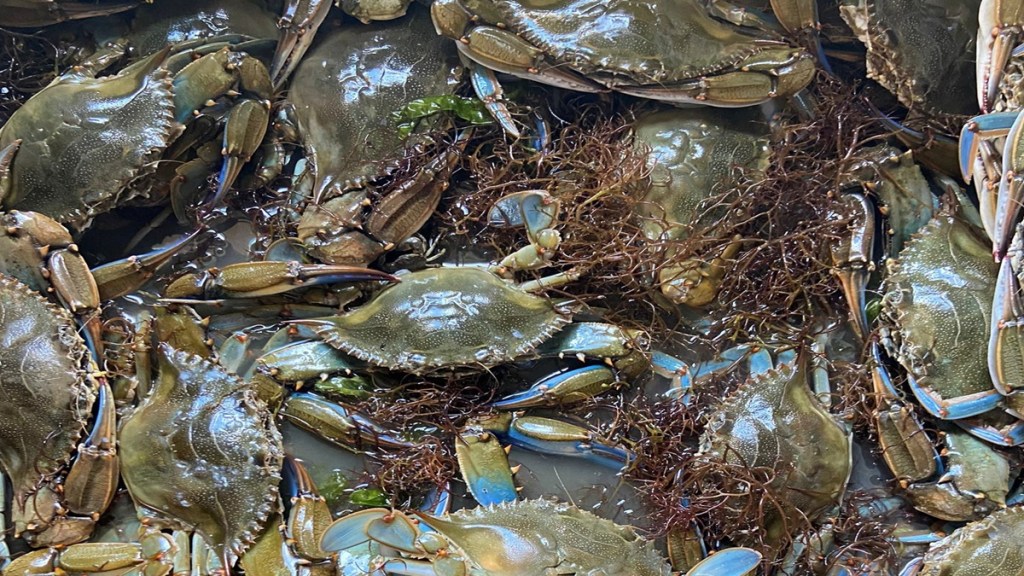Italian communities are confronting a surge in predatory blue crabs, prompting an innovative approach rooted in their rich culinary heritage: when facing an invasion, make a meal out of it.
Concerns have been raised by fishermen, advocacy groups, and environmentalists as the population of these fast-reproducing invasive blue crabs swells during the summer season. These crabs have been wreaking havoc by consuming eels, clams, mussels, and damaging fishing nets.
Acknowledging the persistence of these crabs, farming association Coldiretti and fishing groups have organized a series of events this summer aimed at introducing a classic American summer delicacy to Italian taste buds. One Veneto agriturismo farm-hotel that hosted a Coldiretti event featured a menu showcasing inventive crab dishes, such as rosemary crab salad, crab prepared Venetian style (with onions and vinegar), and pasta with garlic-infused crab.
Davide Sergio, the chef at La Peschereccia, a fishermen’s cooperative in Orbetello on the Tuscan coast, shared, “We usually do crab on the grill or, as in this case, with linguine.”
While these new menu offerings are enticing, they also underscore a potential threat to Italy’s marine ecosystem and fishing industry, particularly the coveted clam harvests that play a pivotal role in dishes like spaghetti alle vongole. Italy holds the distinction of being Europe‘s largest clam producer and the third-largest globally, following China and South Korea, according to UN Food and Agriculture Organisation data from 2021.
The blue crab, known for its strength, speed, and voracious appetite with no natural predators in Italy apart from fishermen, has created a crisis for the country’s clam and mussel producers. Federagripesca, a fishing industry group, estimates that over 50 percent of this year’s shellfish production has been compromised.
In response, the Italian government has allocated 2.9 million euros (USD 3.1 million) to combat the invasion that is devastating shellfish harvests. Moreover, the problem has begun to affect other types of fish farms in various regions of Italy.
In the Orbetello nature reserve lagoon, blue crabs are decimating seabream and eel populations, threatening a wintertime catch that has sustained the local economy for centuries. Evidence of their impact includes eels found without heads or torn to pieces and torn nets from which fish have escaped due to the crabs’ formidable claws.
Marco Giudici, a seasoned fisherman in the Orbetello lagoon, expressed the challenge, saying, “He is aggressive, he is fast, he is an animal of unacceptable intelligence. We fight this blue crab, but he is stronger than us because there are so many of them.”
The Callinectes Sapidus, which has spread worldwide, likely transported in ballast water from ships originating from American coasts, has thrived in the Mediterranean Sea, not only in Italy but also in Albania, Spain, and France.
Blue Crabs were once rare!
As recently as last year, blue crabs were a rarity on the Tuscan coast, but now they are a common sight on fishing boats returning to the dock.
Pierluigi Piro, president of La Peschereccia cooperative, highlighted the environmental concerns, stating, “From an environmental point of view, blue crabs are a real problem because they attack juvenile fish, eels, and disrupt the food cycle by consuming clams, mussels, and oysters. Unfortunately, they are growing exponentially because they seem to have found their ideal habitat in the Orbetello lagoon.”
Adding to the challenge, a female blue crab can produce about half a million to up to 2 million eggs a year, with rising sea temperatures potentially aiding their proliferation.
Enrica Franchi, a marine biologist at the University of Siena, explained, “Usually, at certain times of the year, when the water drops below 10 degrees Celsius, this crab does not live well, but now finds the ideal temperature 12 months of the year.”
While in northeastern Italy, excessive crab catches have led to oversupply issues, in Tuscany, almost all crabs are sold to restaurants or supermarkets. These establishments have begun featuring blue crabs on their fish counters in recent weeks.
The Orbetello cooperative sells crabs at 8 euros per kilogram (USD 4 per pound) to individuals and supermarkets. At restaurants like La Peschereccia, 10 euros (USD 11) can buy a plate of four grilled crabs or linguine with crab in a tomato, onion, basil, and chili pepper sauce, a popular choice that often sells out within the first half hour.
(With AP Inputs)

